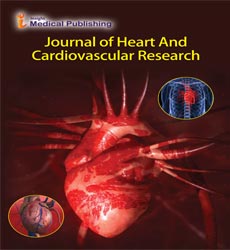ISSN : ISSN: 2576-1455
Journal of Heart and Cardiovascular Research
JAK2/STAT3 Pathway Modulation of Myofibroblast Behavior and PCSk9 Regulation
Ilan Peter*
Department of Cardiovascular Epidemiology, Weizmann Institute of Science, Rehovot, Israel
- *Corresponding Author:
- Ilan Peter
Department of Cardiovascular Epidemiology,
Weizmann Institute of Science, Rehovot,
Israel,
E-mail: Ilan@gmail.com
Received date: November 13, 2023, Manuscript No. IPJHCR-24-18470; Editor assigned date: November 16, 2023, PreQC No. IPJHCR-24-18470 (PQ); Reviewed date: November 30, 2023, QC No. IPJHCR-24-18470; Revised date: December 07, 2023, Manuscript No. IPJHCR-24-18470 (R); Published date: December 14, 2023, DOI: 10.36648/2576-1455.7.03.49
Citation: Peter I (2023) JAK2/STAT3 Pathway Modulation of Myofibroblast Behavior and PCSk9 Regulation. J Heart Cardiovasc Res Vol.7 No.3:49.
Introduction
Myocardial dead tissue is the main source of cardiovascular mortality and proceeds to altogether influence the worldwide illness trouble. Myocardial dead tissue prompts irreversible myocardial putrefaction because of extreme nonstop myocardial ischemia and hypoxia brought about by intense coronary supply route impediment. After myocardial dead tissue, the quantity of working cardiomyocytes diminishes. In this manner, the heart starts fix and renovating. Myofibroblasts discharge Extracellular Matrix (ECM) parts, including type one and three collagen, elastin, and glycosaminoglycan. During this stage, these ECM parts are over-stored between cardiomyocytes, bringing about heart fibrosis. The regulation of myofibroblast multiplication and action are crucial parts in the movement of myocardial fibrosis. Affected by assorted improvements, cardiovascular fibroblasts can change into myofibroblasts. This change is portrayed by the articulation, constriction, and emission of α-Smooth Muscle Actin (α-SMA) and the secretory capability of these cells is fundamentally more grounded than that of fibroblasts. In the beginning phase, the sinewy protein structure in ECM frames the stringy organization of ECM, which defends the heart, keeps up with its generally expected shape, and keeps the heart from breaking. In any case, assuming that this cycle keeps on enacting, it might prompt obsessive cardiovascular renovating. Such remolding could upset the typical systolic and diastolic capability of the heart, bringing about an unexpected intensification of clinical side effects. It can actuate deadly arrhythmias, cardiovascular breakdown, and other serious inconveniences. Thusly, distinguishing focuses for forestalling and treating heart fibrosis and obsessive redesigning after myocardial dead tissue is urgent. This attempt holds critical worth in deciding the result and forecast of cardiovascular sickness.
Innate Hypercholesterolemia
JAK/Detail flagging pathway is connected with the neurotic system of coronary illness. It intervenes cardiomyocyte development, myocardial ischemia-reperfusion injury, myocardial hypertrophy, and myocardial irritation, which assumes a fundamental part in the pathogenesis of coronary illness. A few examinations have shown a critical relationship between the JAK2/STAT3 pathway and the initiation of fibroblasts and tissue fibrosis. Strikingly, the enactment of STAT3 in cardiovascular fibroblasts can work with its separation into myofibroblasts, subsequently advancing multiplication and fibrin discharge. As of late, a developing group of proof plays highlighted the fundamental part played by the JAK2/STAT3 flagging pathway in the perplexing system of heart fix and the ensuing normal rebuilding following myocardial localized necrosis. It predominantly contains a flowing serine protease of 692 amino acids orchestrated by hepatocytes. PCSK9 partakes in various organic exercises inside cells, principally zeroing in on hypercholesterolemia. An enormous number of studies have shown that PCSK9 takes part in the guideline of blood lipids by restricting to Low-Density Lipoprotein Receptors (LDL-Rs), significantly upgrading its debasement. These days, the inhibitor of Proprotein convertase subtilisin/kexin type 9 (PCSK9) addressed by evolocumab has turned into a compelling treatment for dyslipidemia and atherosclerosis. Evolocumab can tie to PCSK9 in blood course. Forestall the debasement of LDL-R interceded by PCSK9, reuse LDL-R back to the outer layer of hepatocytes and keep on assuming the part of eliminating LDL-C from blood.
Heart Fibrosis
Heart fibrosis is essential in the movement of various cardiovascular sicknesses. This peculiarity is hallmarked by an exorbitant testimony of ECM protein discharged by myofibroblasts, prompting expanded myocardial firmness. Proprotein convertase subtilisin/kexin type 9 (PCSK9) is a serine protease that has a place with the proprotein-changing over catalyst family. It has arisen as a feasible helpful objective for decreasing plasma low-thickness lipoprotein cholesterol. Notwithstanding, the specific system through which PCSK9 influences heart fibrosis stays muddled. In the current exploration, an expansion in coursing PCSK9 protein levels was seen in people with myocardial localized necrosis and rodent models of myocardial dead tissue. In addition, the restraint of flowing PCSK9 in rodents was found to diminish post-dead tissue fibrosis. In vitro analyzes additionally showed that overexpression of PCSK9 or excitement by extracellular PCSK9 recombinant protein improved the change of cardiovascular fibroblasts to myofibroblasts. This interaction likewise raised collagen one and three, as well as α-SMA protein levels. Nonetheless, these impacts were countered when co-hatched with the STAT3 inhibitor S3I-201. This study proposes that PCSK9 might work as an original controller of myocardial fibrosis, principally through the JAK2/STAT3 pathway.
Open Access Journals
- Aquaculture & Veterinary Science
- Chemistry & Chemical Sciences
- Clinical Sciences
- Engineering
- General Science
- Genetics & Molecular Biology
- Health Care & Nursing
- Immunology & Microbiology
- Materials Science
- Mathematics & Physics
- Medical Sciences
- Neurology & Psychiatry
- Oncology & Cancer Science
- Pharmaceutical Sciences
